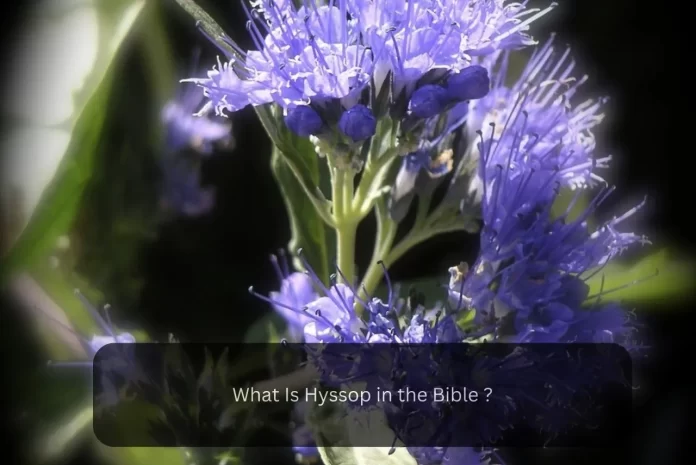Hyssop in Historical and Cultural Context:
Hyssop (Hyssopus officinalis) is a fragrant herb that has a rich history and cultural significance spanning across various civilizations and time periods. Here’s a look at hyssop in historical and cultural contexts:
- Ancient Egypt: Hyssop is believed to have been used in ancient Egypt for both medicinal and ceremonial purposes. It was used in rituals, including purification and cleansing ceremonies. In the biblical story of the Passover, hyssop is mentioned as the plant used to apply the lamb’s blood to doorposts, protecting the Israelites from the plague.
- Biblical References: Hyssop is mentioned multiple times in the Bible, particularly in the Old Testament. It’s often associated with purification, cleansing, and spiritual renewal. In addition to the Passover story, hyssop is mentioned in Psalms 51:7: “Purge me with hyssop, and I shall be clean; wash me, and I shall be whiter than snow.”
- Ancient Greece and Rome: Both ancient Greek and Roman cultures recognized hyssop for its medicinal properties. It was used to treat respiratory issues, digestive problems, and as an antiseptic. Greek physician Dioscorides mentioned hyssop in his works on herbal medicine.
- Medieval Europe: During the medieval period, hyssop continued to be valued for its medicinal properties. It was used in various remedies, tonics, and teas to treat respiratory ailments and promote overall well-being.
- Folklore and Symbolism: Hyssop has also been associated with various folklore and symbolic meanings. In some cultures, it was believed to have protective and purifying properties, often used to ward off evil spirits or negative energy. Its strong aroma and cleansing reputation contributed to these beliefs.
- Traditional Medicine: Hyssop has been a staple in traditional herbal medicine for centuries. It was used to treat coughs, colds, respiratory infections, and digestive issues. The essential oil derived from hyssop was used in aromatherapy for its invigorating and uplifting effects.
- Culinary Uses: In addition to its medicinal uses, hyssop has been used as a culinary herb. Its leaves have a slightly bitter, minty flavor and were sometimes used to flavor dishes, teas, and liqueurs.
- Modern Usage: Hyssop is still utilized today in herbal medicine and aromatherapy. Its essential oil is used in some natural remedies and as a fragrance in perfumes and soaps. However, it’s important to note that herbal remedies should be used with caution and under the guidance of qualified practitioners.
Hyssop’s historical and cultural significance is closely tied to its aromatic properties, as well as its perceived cleansing and purifying qualities. It has left an enduring mark on various cultures and continues to be valued for its unique characteristics.
Hyssop’s Biblical References:
Hyssop is mentioned several times in the Bible, particularly in the Old Testament, where it holds symbolic and ritualistic significance. Here are some of the notable biblical references to hyssop:
- Exodus 12:22 (Passover): In the context of the Passover story, hyssop is mentioned as the plant used to apply the blood of a sacrificial lamb to the doorposts of Israelite households. This act marked them as protected from the final plague sent by God, which was the death of the firstborn. This reference is significant in that it portrays hyssop as a tool of purification and protection.
- Leviticus 14:4-7 (Cleansing Ritual): Hyssop is mentioned in the context of a cleansing ritual for someone who has recovered from a skin disease. It’s used along with cedar wood, scarlet yarn, and a live bird to sprinkle water over the person being cleansed. The use of hyssop in this ritual again highlights its symbolic role in purification.
- Numbers 19:6 (Cleansing with the Red Heifer): In the regulations for purification with the ashes of a red heifer, hyssop is mentioned as one of the materials used to prepare the cleansing solution. This underscores the herb’s role in rituals of purification and cleansing.
- Psalm 51:7 (Purification and Forgiveness): The psalmist uses the metaphor of hyssop to express the desire for spiritual cleansing and forgiveness: “Purge me with hyssop, and I shall be clean; wash me, and I shall be whiter than snow.” This verse is part of Psalm 51, a penitential psalm attributed to King David after his affair with Bathsheba. The use of hyssop here symbolizes the psalmist’s longing for spiritual purity and renewal.
Symbolism and Spiritual Meanings:
- Purification and Cleansing: Hyssop is frequently used in the Bible in contexts related to purification and cleansing. The act of sprinkling or applying substances with hyssop was believed to have a purifying effect, both physically and spiritually. This symbolism is rooted in the herb’s aromatic properties and its historical use in cleaning and medicinal practices.
- Spiritual Renewal and Forgiveness: The use of hyssop in passages like Psalm 51:7 reflects a desire for spiritual renewal and forgiveness. King David’s plea to be cleansed with hyssop after his transgressions highlights the herb’s symbolic role in seeking reconciliation with God and achieving a state of spiritual purity.
- Protection and Redemption: In the Passover story, hyssop is used to mark the Israelite households so that they are protected from the final plague. This act of applying blood with hyssop symbolizes not only protection but also redemption. The use of hyssop serves as a visual reminder of God’s deliverance and the covenant between God and the Israelites.
- Humility and Surrender: Hyssop’s lowly and humble nature in the plant kingdom is sometimes seen as a symbolic representation of humility and surrender before God. Just as hyssop is a modest plant, those who turn to God in repentance and seek cleansing are called to approach with humility and contrition.
- Ritual and Symbolism: The repeated use of hyssop in various rituals, such as cleansing ceremonies, underscores its role as a symbol of spiritual transition. The act of using hyssop to apply substances symbolizes the desire to be purified and made clean before God, emphasizing the importance of inner purity and devotion.
Hyssop Beyond the Bible:
Hyssop (Hyssopus officinalis) has a rich history of use in various ancient cultures for its medicinal, culinary, and religious purposes. Here’s a look at its historical and cultural uses:
-
Medicinal Uses:
- Ancient Egyptians: Hyssop was used by the ancient Egyptians for its potential medicinal properties. It was believed to have healing qualities and was used in herbal remedies for respiratory ailments and digestive issues.
- Ancient Greeks and Romans: Both the Greeks and Romans recognized hyssop’s medicinal value. They used it for its expectorant and antiseptic properties, using hyssop infusions to treat respiratory problems and sore throats.
- Traditional Medicine: In traditional European herbal medicine, hyssop was often employed as a remedy for coughs, bronchitis, and congestion. It was also used for its potential digestive benefits and as a mild stimulant.
-
Culinary Uses:
- Flavoring: Hyssop leaves have a strong, aromatic flavor and were used in cooking to add a minty, slightly bitter taste to dishes. It was often used to season meats, stews, and soups.
- Garnish: The attractive purple or blue flowers of hyssop were sometimes used as an edible garnish in salads and desserts.
-
Religious and Cultural Significance:
- Ancient Hebrews: As mentioned earlier, hyssop held significant religious importance in ancient Hebrew rituals. It was used for purifications and cleansing ceremonies, symbolizing spiritual renewal and forgiveness.
- Ancient Greek and Roman Rituals: Hyssop was used in purification rituals and as a sacred herb in temples. It was also used to cleanse sacred spaces and was associated with rituals for protection and purification.
- Christian Symbolism: Hyssop’s role in the crucifixion of Jesus, as mentioned in the Gospel of John, has led to its incorporation into Christian symbolism. The act of offering a sponge soaked in sour wine on a hyssop branch to Jesus has been interpreted as a symbol of mercy and salvation.
-
Folklore and Superstitions:
- Hyssop has been associated with various folklore and superstitions in different cultures. In some traditions, it was believed that hyssop could ward off evil spirits and protect against negative energies.
- In folk medicine, hyssop was sometimes used in amulets and charms for its perceived protective properties.
-
Aromatherapy and Perfume:
- Hyssop’s aromatic properties made it a candidate for use in perfumes and incense in ancient times. Its pleasant fragrance contributed to its role in purification rituals.
-
Dyeing:
-
- The plant’s flowers were used to produce a blue dye in some cultures. This dye was sometimes used for textiles or decorative purposes.
Lessons and Applications:
Here are some lessons and applications drawn from the biblical references to hyssop:
- Purification and Cleansing: Just as hyssop was used in ancient rituals for purification and cleansing, its symbolism teaches us the importance of inner purification. Just as physical spaces were cleansed, we should strive to cleanse our hearts and minds from negative emotions, prejudices, and impurities.
- Humility and Obedience: In the story of the Passover and Exodus, the use of hyssop to apply the lamb’s blood required obedience to God’s instructions. This teaches us the value of humility and obedience in our spiritual journey. Like hyssop’s simple role, we should humbly follow divine guidance.
- Forgiveness and Renewal: King David’s plea to be “purged with hyssop” in Psalm 51 reflects a desire for spiritual renewal and forgiveness. Hyssop’s symbolism encourages us to seek forgiveness for our mistakes and to approach renewal with a contrite heart.
- Compassion and Mercy: The act of offering a sponge soaked in sour wine on a hyssop branch to Jesus during his crucifixion is a gesture of compassion and mercy. This teaches us about the transformative power of showing kindness and compassion, even in difficult circumstances.
- Symbol of Sacrifice: The role of hyssop in applying the lamb’s blood on the doorposts during Passover highlights the concept of sacrifice. This can remind us of the sacrifices people make for the sake of higher ideals, whether in religious contexts or in acts of selflessness.
- Protection and Shelter: The use of hyssop in the Passover story also underscores the idea of protection. Just as the blood marked the homes for protection, hyssop’s symbolism can remind us of seeking spiritual protection and finding refuge in our faith.
- Unity and Inclusivity: Hyssop’s role in purification rituals shows its ability to bring people together in a shared purpose. This symbolizes the value of unity, inclusivity, and the idea that spiritual growth can be a collective endeavor.
- Symbol of Growth and Renewal: In a literal sense, hyssop is a perennial plant that grows anew each season. This growth and renewal can symbolize the cycle of life, death, and rebirth, reminding us of the continuous opportunities for personal growth and transformation.
Modern Implications and Relevance:
Hyssop’s symbolism, derived from its historical and cultural significance in ancient times and its portrayal in the Bible, holds relevance in modern times for several reasons:
- Spiritual Reflection and Renewal: In an age marked by busy schedules and constant distractions, the symbolism of hyssop can serve as a reminder to pause, reflect, and seek inner renewal. Just as in biblical times, people today can benefit from taking time to cleanse their minds, hearts, and spirits from negativity and impurities.
- Forgiveness and Compassion: The themes of forgiveness and compassion conveyed through hyssop’s symbolism remain universal and timeless. In a world often marked by conflicts and divisions, these qualities can contribute to healing and reconciliation, promoting a more harmonious society.
- Self-Care and Mental Health: Hyssop’s symbolism of purification and cleansing can be applied to self-care practices and mental health. Just as ancient cultures used hyssop for its potential healing properties, individuals today can use this symbolism to prioritize their mental, emotional, and spiritual well-being.
- Community and Unity: The symbolism of hyssop’s use in communal rituals emphasizes the importance of unity and shared experiences. This holds relevance in the modern world, where fostering a sense of community can counteract feelings of isolation and promote social cohesion.
- Environmental Awareness: Hyssop’s symbolism also points to humankind’s connection with the natural world. In an era of environmental concerns, the symbol of hyssop can remind us of the need to respect and care for the environment, aligning with a broader sense of stewardship.
- Symbolic Depth in Faith: For those who follow religious or spiritual paths, hyssop’s symbolism can add layers of depth to their understanding. It can be incorporated into contemporary spiritual practices as a reminder of timeless values such as humility, obedience, and seeking spiritual protection.
- Personal Growth and Transformation: The concept of renewal and transformation, central to hyssop’s symbolism, is a constant pursuit for individuals seeking personal growth and positive change. The symbol of hyssop can inspire individuals to embrace change and continually strive for self-improvement.
- Interfaith and Cross-Cultural Understanding: Hyssop’s symbolism spans multiple cultures and religions. In an increasingly diverse world, its symbolism can serve as a bridge for interfaith dialogue and cross-cultural understanding, promoting tolerance and respect.
Conclusion:
In the tapestry of biblical narratives, hyssop emerges as a seemingly simple yet profoundly symbolic element. Its appearances in stories of purification, forgiveness, and protection reveal its significance as a conduit for profound spiritual lessons. Hyssop’s symbolism, rooted in ancient rituals and practices, remains ever-relevant in our modern world. It teaches us the value of self-reflection, humility, and the pursuit of inner cleansing and renewal. Moreover, hyssop’s representation of compassion and unity carries a message that transcends time and culture, urging us to cultivate kindness and empathy in an increasingly interconnected global society. As we delve into the rich layers of its meaning, hyssop beckons us to engage with its wisdom, allowing its symbolism to inspire growth, foster spiritual connections, and guide us toward a more harmonious and enlightened existence.
FAQ
Q1: What is hyssop?
Ans: Hyssop is a plant with culinary and medicinal uses.
威而鋼
style=”font-size: 14pt;”>Q2: How is hyssop used in cooking?
Ans: Hyssop can be used as an herb to add flavour to dishes.
Q3: What are the medicinal benefits of hyssop?
Ans: Hyssop has been used for digestive and respiratory issues in traditional medicine.
Q4: How is hyssop used in purification rituals?
Ans: Hyssop was used in ancient times to apply blood and symbolise purification.
Q5: What is hyssop in the bible ?
Ans: Hyssop in the Bible symbolizes cleansing and purification.







